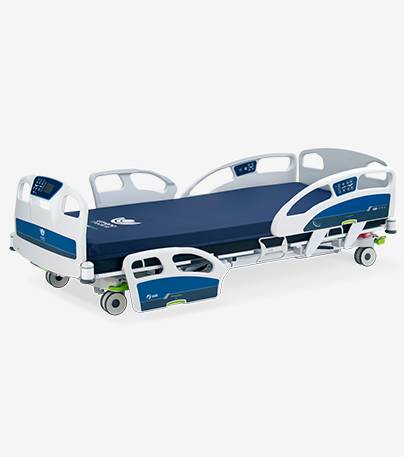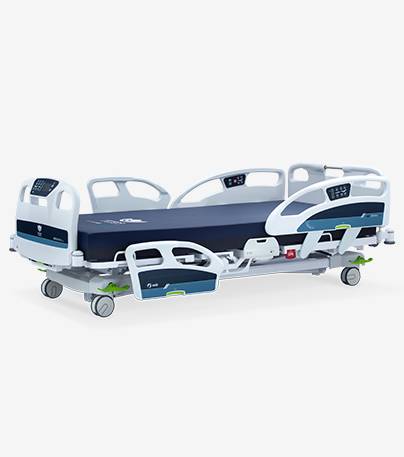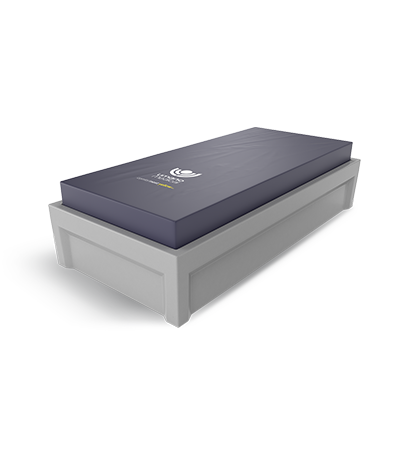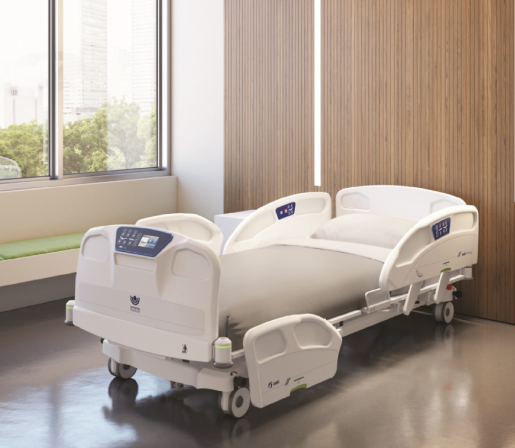
How to choose the right hospital bed for your hospital
Key factors to consider when choosing a hospital bed
As healthcare equipment continues to advance, the role of the hospital bed has evolved significantly.
What used to be considered a “piece of furniture,” the hospital bed has transformed into an integral piece of therapeutic medical equipment that can substantially affect patient experience and treatment outcomes.
The choice of a hospital bed should be guided by a deep understanding of the facility’s needs, patient demographics, and the specific challenges healthcare providers face on a daily basis. Let’s explore them in more detail.
Medical beds: A modern solution to hurdles in healthcare environments
As healthcare facilities strive for improved patient outcomes and operational efficiency, the selection of hospital beds can significantly impact various critical areas.
A properly chosen hospital bed can drastically reduce staff injuries. By integrating features such as adjustable height settings and enhanced mobility, contemporary hospital beds help prevent physical strain on healthcare workers, thereby reducing the occurrence of workplace injuries.
Furthermore, hospital-acquired pressure injuries (HAPIs) and infections (HAIs) can also be mitigated through the use of advanced bed surfaces designed for better patient management and ease of cleaning. Specialized support surfaces for hospital beds allow staff to more easily follow infection control protocols and reduce the likelihood of pressure injuries, both which directly affect a healthcare facility's adherence to its HAPI and HAI prevention goals.
Patient safety and satisfaction are directly influenced by the quality and functionality of hospital beds. Medical beds equipped with customizable positions and patient-friendly controls enhance the patient experience, increasing satisfaction by providing comfort and autonomy over bed adjustments.
Moreover, Safe Patient Handling and Mobility (SPHM) programs and early mobility initiatives benefit from hospital beds that provide a range of mobility levels. These features facilitate early patient movement, which can prevent complications related to prolonged hospitalization.
Finally, the economic impact of choosing the right hospital bed cannot be overlooked. Investing in high-quality, versatile hospital beds reduces the need for and cost associated with rental equipment. This also contributes to staffing retention, satisfaction, and engagement by demonstrating a commitment to providing the best tools and environment for patient care.
Educating staff on how to use standardized beds efficiently reduces time spent on training and maximizes the effectiveness of hospital resources. By ensuring that hospital beds can meet these varied needs, healthcare facilities create a safer, more efficient, and patient-centric environment.

Acuity adaptable hospital beds: The new frontier
The emergence of a new generation of medical beds, known as acuity adaptable hospital beds, is marking a significant advancement in healthcare delivery, the efficiency and safety of clinical staff, and hospital performance.
Acuity adaptable hospital beds are a flexible solution that caters to diverse patient needs while providing a certain level of standardization. For example, acuity adaptable hospital beds can be used in various care environments, such as Med-Surg, high-acuity care, long-term acute care, behavioural health environments, and palliative care units.
These beds offer various features that allow you to care for a variety of patients in a variety of settings while helping staff achieve a multitude of goals.
And with the right acuity adaptable hospital bed partner, healthcare teams can use the medical bed’s features appropriately, molding them into current facility policies and procedures—rather than the other way around—and enabling customization of equipment based on your unique needs.
How to choose the best acuity adaptable hospital bed for your facility
When selecting hospital beds, healthcare facilities must prioritize a complex array of requirements to ensure they are making the best choice for their specific needs. It takes a multi-pronged approach that involves all stakeholder, including nursing managers and other clinical staff, biomedical technicians, procurement, and upper management.
Start by understanding your facility’s current performance and associated costs of fall rates, HAIs, HAPIs, and Hospital Consumer Assessment of Healthcare Providers and Systems (HCAHPS). What’s working and what’s not?
Ask nursing staff about issues with your current medical beds. Are they too high or too low? Are they incompatible with other hospital equipment, such as lifts and overbed tables? Do patients complain about the hospital beds? What is the level of staff injuries that are caused by working with the beds and patient handling? Engaging with healthcare staff will enable you to tap into a wealth of information that will drive your search for the best acuity adaptable hospital bed for the team.
Other points to evaluate is the current service levels, contract compliance and sheer number of medical bed suppliers your facility currently works with. Are your hospital beds currently difficult to repair? Are lead times on service parts becoming unacceptable? How easy is it to get support from the manufacturers when troubleshooting the use and maintenance of your fleets of hospital beds? Evaluating the costs and complexity of juggling different hospital bed vendors should also be considered—from operational, logistics, and staff productivity standpoints.
Once you’ve painted a complete picture of your facility’s needs and what prioritized challenges need to be addressed, you will have built the foundation for appraising different brands of acuity adaptable hospital beds.
What to look for in acuity adaptable hospital beds
When choosing acuity adaptable hospital beds, it's imperative to understand the features that will best meet the needs of your healthcare facility.
This guide will walk you through the essential characteristics to consider, helping you make an informed decision that aligns with the objectives you have set for your care environments.

Top hospital bed features
Here are some of the key hospital bed features to look for:
- Hospital bed size: The size of the hospital bed must accommodate the diverse patient population a facility serves. Standard beds may not suffice for all patients, especially in terms of width and length. Facilities must consider medical beds that offer integrated width and length extenders for tall and bariatric patients.
- Hospital bed height: Look for acuity adaptable hospital beds with bed frames offer a variable enough low-to-high height to accommodate the majority of patients as well as provide enough underbed clearance for other medical equipment.
- Weight capacity: Some medical beds have boosted weight capacity of over 1000 lbs., making them ideal for bariatric environments.
- Patient ingress and egress: Make sure that the acuity adaptable hospital beds provide safe patient ingress and egress zones. Medical beds should enable patients to easily get their feed and hands in the right positions to facilitate sitting and standing.
- Medical bed adjustments: New designs in hospital bed frames enable staff members to adjust the heads and feet of the bed to minimize patient shear and friction.
- Easy maneuverability: To help improve patient transport and reduce injuries to employees, the hospital bed should be able to accommodate a power drive system or at least feature a 5th wheel.
- Standardized interface: Search for acuity adaptable hospital beds with frames that offer the same user interface across various configurations and in different care environments. This will go a long way to decreasing staff frustration and error as well as training times and costs.
- Intuitive interface: Does the hospital bed feature one-touch buttons for more precise patient repositioning? Are you able to program and monitor bed settings for patient safety and to carry out mobility plans? Does it offer clear communication between staff regarding patient protocols—even when off unit?
- Versatile bed-exit detection: Ask hospital bed manufacturers how many levels of detection are offered. Do they feature different types of alerts, and can the volume/tone be adjusted? Is there any way to automate the engagement of the alarms to minimize user error and employee forgetfulness?
- Support for infection protocols: Carefully inspect the medical beds. They should be smooth and with no cumbersome parts. Do they have textured surfaces, movable pieces or pockets that could complicate cleaning? Are their hard-to-disinfect areas that will bog down EVS workers?
These are just some of the hospital bed features to look for in acuity adaptable hospital beds.
There are other aspects you may want to think about, such as patient controls to elevate the patient experience, one-hand release siderails, intelligent night lights, integrated scale and more.
Find your ideal hospital bed now.
Contact a rep
The role of support surfaces with new hospital beds
If your healthcare facility is aiming to update its medical bed fleet, it is also important to think about hospital bed support surfaces.
Factoring in support surfaces at the same time as purchasing medical beds beds, especially from the same manufacturer, offers several interconnected benefits that enhance both the efficiency of the procurement process and the quality of patient care.
When beds and support surfaces are designed to function together as a system, compatibility is ensured, which optimizes both functionality and performance. This seamless integration avoids the complications that can arise from mismatched equipment that may not fit well together, potentially compromising patient safety and comfort as well as slowing down team efficiency.
Procuring these items from a single source also simplifies logistics, reducing the complexity and coordination required when dealing with multiple suppliers. This streamlining can lead to quicker deployment of new equipment in patient rooms, allowing for faster readiness for patient care.
Purchasing from the same manufacturer ensures consistent quality across products, as similar standards and technological innovations are likely applied across their product lines.
Dealing with one manufacturer simplifies warranty and service agreements, providing more comprehensive coverage and easier service management. In cases of equipment failure or the need for repairs, having a single point of contact can accelerate service responses.
You can discover more tips on choosing a support surface for patients here.
Future-proof your new hospital beds
Forward-looking manufacturers are developing game-changing acuity adaptable hospital beds with platforms for remote display and consultation of bed information to optimize the work of clinical and administrative staff. In fact, they connect the patient bed to the nurses’ station and maintenance department, simplifying team collaboration and saving time.
The benefits of these platforms are indeed compelling. Staff members can:
- Easily monitor bed groups and follow prevention protocols
- Access real-time bed status and event data
- Carry out preventative and predictive maintenance to extend the hospital beds’ useful life
- Decrease bed downtimes
- Connect bed insights to other third-party systems if design with open architecture
One such platform is Umano Connect, which can be used on all of Umano Medical’s acuity adaptable hospital beds.
Discover more about Umano Connect
Medical bed customer service and warranty
Remember that when you purchase hospital beds, an essential aspect is the level of service the manufacturer provides. Some legacy medical equipment vendors tend to focus on providing equipment supply. But there’s so much more to adding a new fleet of hospital beds to your facility.
Work with a manufacturer that offers a proven track record of white-glove service. Look for 24/7/365 live technical support, same-day part shipping, on-site assistance during delivery and installation, specialists available on-site within 72 hours, and all-inclusive parts coverage from damage resulting from unintentional negligence and misuse as part of your hospital bed procurement.
A warranty of 10 years on hospital beds, which guarantees that the medical beds are in patient-ready conditions for a decade gives added peace of mind that a healthcare facility’s investment will last. Keep that in mind.
Ask your hospital bed manufacturer about its medical bed service plans and if they have add-ons, like:
- In-house technician certification that are eligible for a labor-reimbursement program
- Preventative maintenance services
- Back-up units to mitigate emergency downtimes
- Customized service boxes to speed up repair turnaround time
- All-inclusive labor coverage
Medical bed product development: Co-creation for innovation
A strong collaborative relationship with a medical bed manufacturer allows for input into future product development and customization as a facility or care unit’s needs evolve.
This type of partnership allows healthcare providers to influence the design and features of the beds to better meet specific clinical requirements and ensures that the beds can adapt to changes in healthcare practices and patient demographics over time.
By working closely with a manufacturer that is open to co-development, listens to facilities’ feedback, and understands at on-the-ground experiences drive innovation, you can be a part of creating more efficient, patient- and employee-centered hospital beds. If your hospital bed manufacturer fosters long-term joint ventures with innovation centers and trusted healthcare institutions, you know that it is committed to clinical performance.
Discover our customizable hospital beds
In sum, selecting the right hospital bed for your healthcare facility is a multifaceted decision. From ensuring the bed's adaptability to specific patient needs to considering the long-term operational and financial benefits, every aspect must be carefully examined.
By thoroughly understanding your facility's specific requirements and the available hospital bed options, you can make an informed choice that will benefit both patients and healthcare providers for years to come.
Let us help you optimize patient care
Related articles

Headquarters
230 Nilus-Leclerc Blvd.
L'Islet, QC G0R 2C0
CANADA
1 844 409-4030
Lévis Office
470 3e Avenue
Lévis, QC G6W 5M6
CANADA
US Location
11845 Adie Rd.
Maryland Heights, MO 63043
UNITED STATES
Sherbrooke Office
670, Joseph-Louis-Mathieu Rd.
Sherbrooke, J1R 0X3
CANADA
Careers
Our talented and passionate team is determined to revolutionize the medical industry. Be part of the journey: join the Umano Experience.
See available jobsConnect with us
Copyright © 2025 Umano Medical inc







